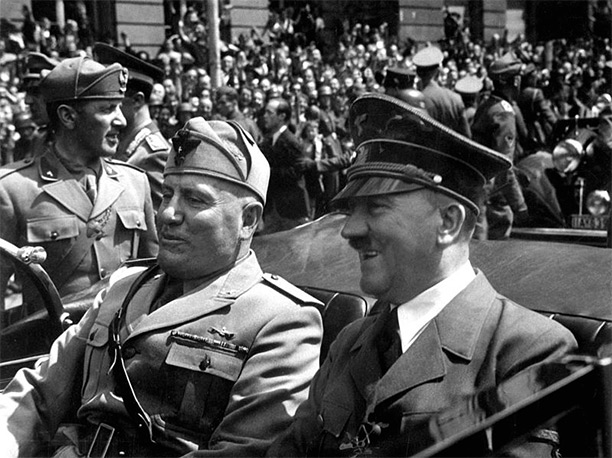Hitler and Mussolini meet in Rome
The two dictators met on May 3rd, 1938.

It was not the two dictators' first meeting, which had occurred in Venice four years previously. Mussolini had not taken Hitler seriously until the 1930 German election, when he began giving Hitler advice on tactics. Hitler failed to take it and when the two men met in 1934 they were not in accord. In 1935 the Germans even secretly supplied arms to the Emperor Haile Selassie for defence against the Italian invasion of Ethiopia.
By January 1936, however, Mussolini was telling a German envoy that Nazi Germany and Fascist Italy shared ‘a common destiny’; that summer the two powers worked together in Spain, and in November Mussolini described the relationship between the two countries as the ‘axis’ around which Europe would revolve. Mussolini visited Germany in September 1937 in a display of Fascist-Nazi solidarity and when Hitler took over Austria in March 1938, Germany was patently the dominant partner in the relationship, with the German army perched on the Italian frontier.
Hitler arrived in Rome on May 3rd, accompanied by Goebbels and Ribbentrop as well as some five hundred party officials, diplomats, security guards and journalists in three trains. A special station had been built for the Germans, who were greeted by Mussolini and King Victor Emmanuel. Rome was adorned with decorations, including swastikas, and a new street, the Via Adolf Hitler, had been constructed, along which the German leader was driven to the Quirinal Palace, where he stayed as guest of the king. Victor Emmanuel and Hitler found each other tiresome. Hitler was uncomfortable at the court and felt with reason that he was treated with disdain. The king is said to have asked the German leader how many nails there were in the German infantry boot, and when Hitler did not know, explained at some length that the Italian boot had fifty-two nails in the sole and twenty-two in the heel.
The next day was devoted to a tour of Rome and two private meetings between the Führer and the Duce, and in the evening they reviewed the Italian fleet in Naples. The Vatican remained ostentatiously aloof, but there was a state banquet on May 8th at which the two leaders made speeches of German-Italian solidarity and Hitler announced that Germany regarded the Italian frontier ‘for ever as unchangeable’.
After visiting Florence on May 9th Hitler and his group returned to Berlin the following day. He had privately pressed for a military alliance between the two countries, which at this point Mussolini refused, though in the summer he copied the Germans by introducing anti-Jewish legislation. He had now decided that the Mussolini family was Nordic and related to the ‘purer’ Germans rather than the Latins, though he had earlier dismissed Nazi racial theories as ‘anti-scientific drivel’. The relationship with Germany would dominate Italian foreign policy all the way to war; in May 1939 they signed a formal treaty, the so-called ‘pact of steel’.




